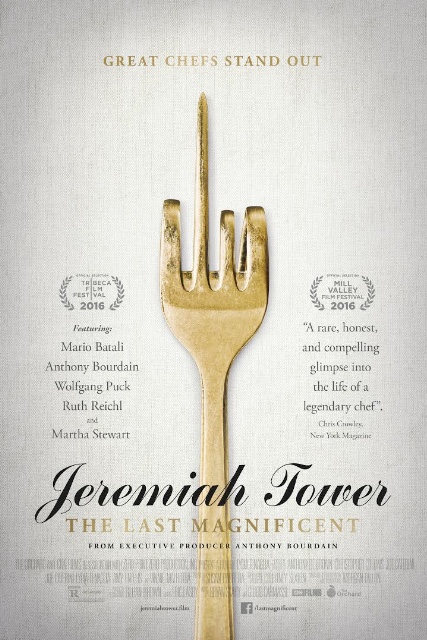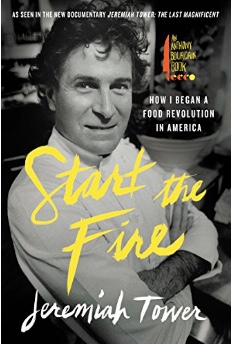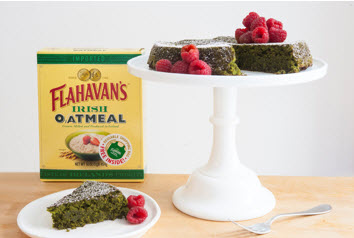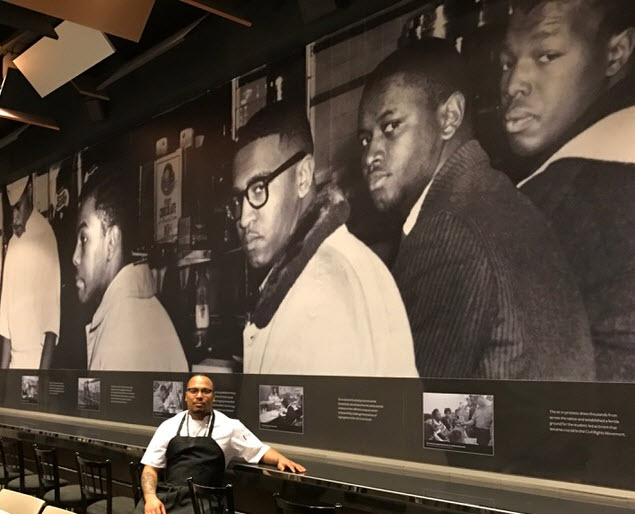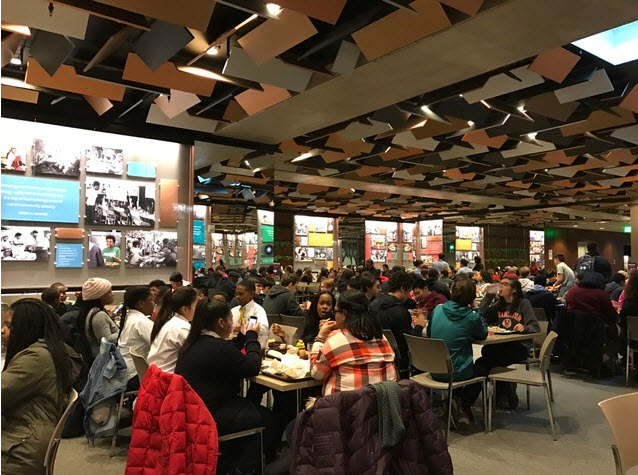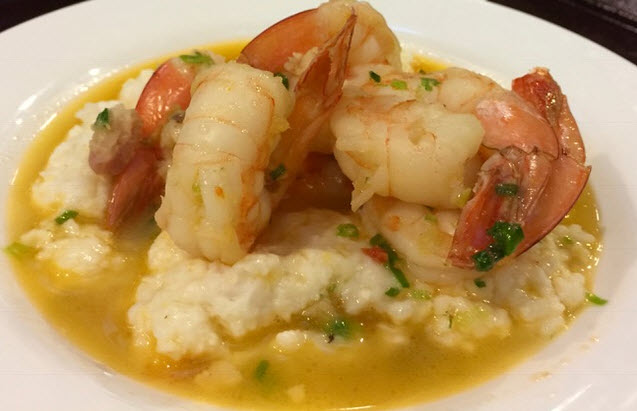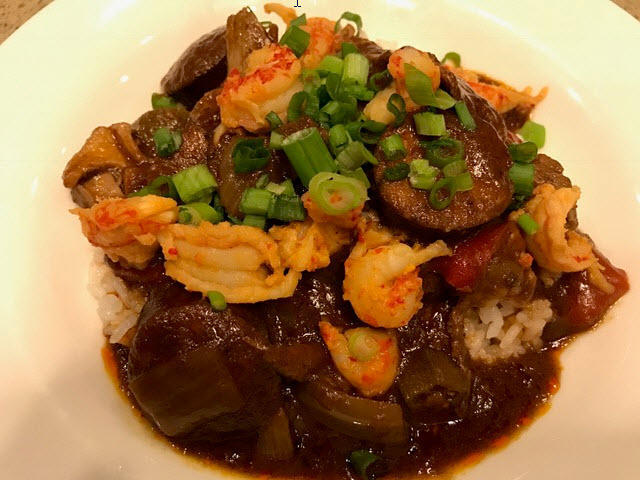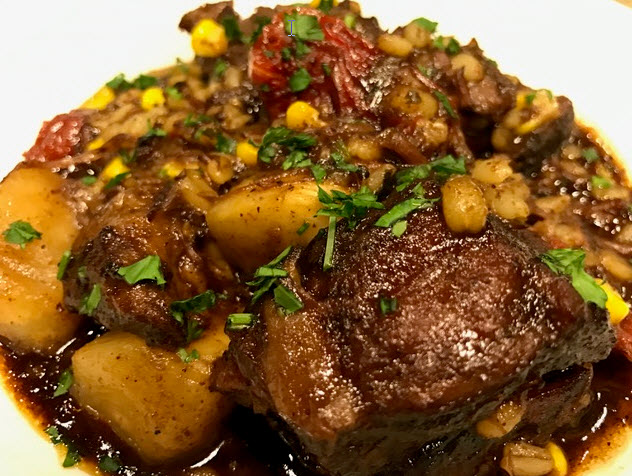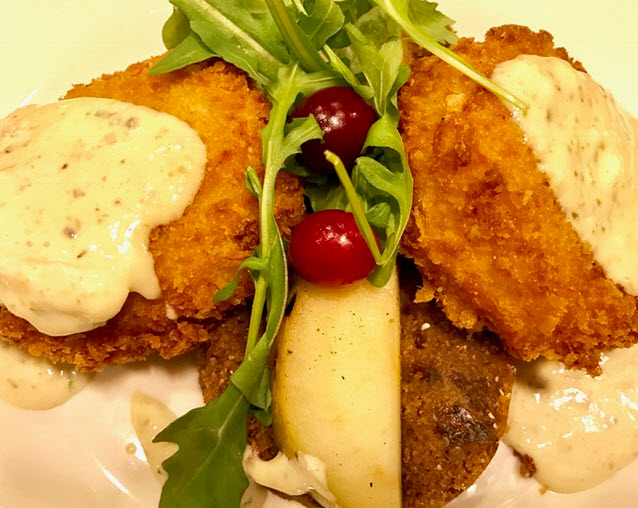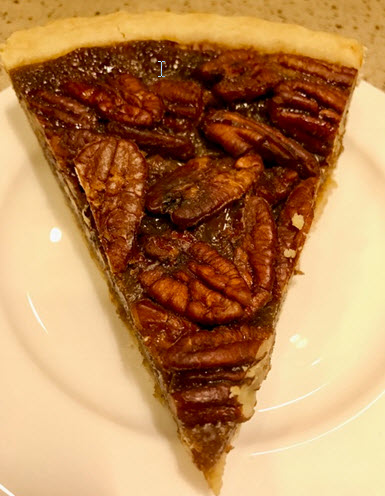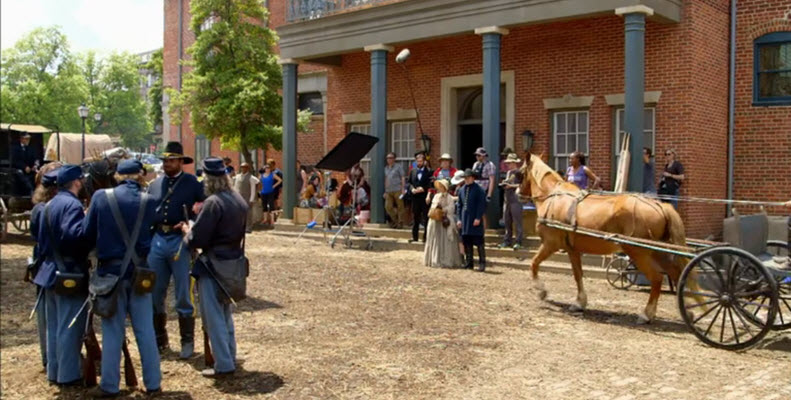Jordan Wright
September 15, 2016
All photo credit – Jordan Wright
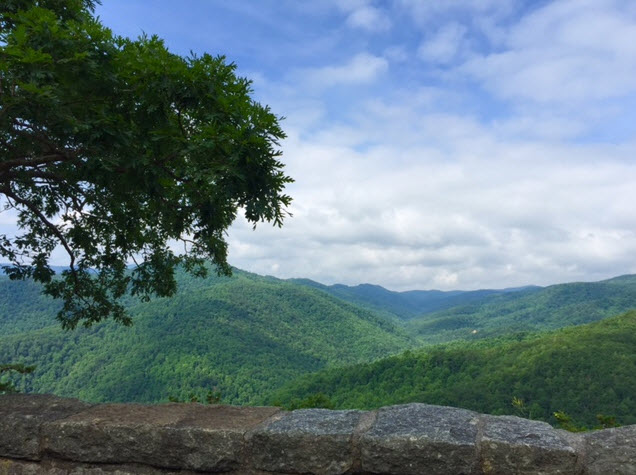
The view from 20-Minute Cliff
Usually a trip through Nelson County has us making a beeline to Charlottesville. And though Thomas Jefferson’s university town has beauty, history and terrific restaurants, there are tons of other attractions in this bucolic county worthy of a visit – and a few night’s stay. Let Route 151 be your guiding star. For our adventure we allowed five days and four nights, and only scratched the surface, vowing to return to the places we discovered and those we’d heard about and missed. And although this is piece is entirely subjective, feel free to design your own trip by cherry-picking from our favorites.

Farms dot the landscape on the Blue Ridge
Once past the Manassas exit on Route 66, the road opens up to spectacular vistas, rolling countryside and the eastern side of the Blue Ridge Mountains. Bill Coffee’s family-owned Buckland Farm Market outside of Warrenton on Route 29, is always our first stop. The large farm store has a dizzying array of homemade cheeses, fresh fruits and veggies, plants and preserves, and more importantly, a wide array of mouth-watering baked goods. In autumn there are pumpkin turnovers and pumpkin whoopee pies along with Southern pecan and apple pies. You’ll also find the widest selection of Bob’s Red Mill products. If you’re on an overnight stay, bring a cooler and stop on the way home for farm-raised beef and eggs. The haunted corn field will open weekends throughout October and pick-your-own pumpkins are in the field now.

The Spa at Wintergreen Resort
After purchasing a few jars of local honey and the prerequisite snacks, we proceeded up the mountains to check in at Wintergreen Resort, heading post haste to the serenity of The Spa for massages. The full-service spa offers a variety of options and we chose a combination of Swedish, deep tissue and reflexology. The ‘Green Tea and Lemongrass’ stress-shedder includes a salt scrub, hot stones and Vichy shower for the ultimate in relaxation. From now till November the treatment switches over to the autumn-inspired ‘Pumpkin Chai’ sugar scrub. Afterwards don plush terry robes and relax with a cup of herbal tea in the lounge overlooking the woods, or a swim in the indoor pool. Finish your hydrotherapy in the steam room or sauna before heading off to dinner.

Fresh cut bouquet from Pharsalia
Wintergreen has several dining options and the Copper Mine Bistro in the heart of Blackrock Village is the homiest of all. Have breakfast here if you are planning on morning activities at the resort. Golf, tennis, mountain biking and skiing are the most vigorous activities, but for less of a workout there’s yoga, trail walking and swimming. Visit the Nature Center to learn about the flora and fauna and archeological history of the area. Guided walks leave from here or you can venture out on your own using their free trail maps.
Devil’s Grill is the resort’s fine dining restaurant. And as with the other four restaurants, guests can go casual, though here tables are dressed up with candles, flowers and white linens signaling a fancier repast. A new chef has arrived since we dined there in late June, but expect locally-sourced seasonal food with a gourmet flair.
The morning brought rain and mist and the fern-bordered path to the Copper Mine Bistro was dense with fog. Weather in the mountains has a habit of improving after a few hours and by the time breakfast was over the sun had broken through the clouds and we took off for the mountain course to make an early tee time.

Devil’s Knob golf course
Devil’s Knob is the most challenging of the two courses (18 holes at Devil’s Knob and 27 holes at Stoney Creek), and I’m afraid in our zeal we didn’t do it justice. But it was worth every scenic moment. Sitting at an elevation of 3,800 feet and cooler than its sister course, Stoney Creek (designed by Rees Jones), we found wildflowers and wildlife our chief distractions. This beautifully laid out Ellis Maples designed course takes advantage of the spectacular mountain views and rushing streams cascading down from the mountain tops.
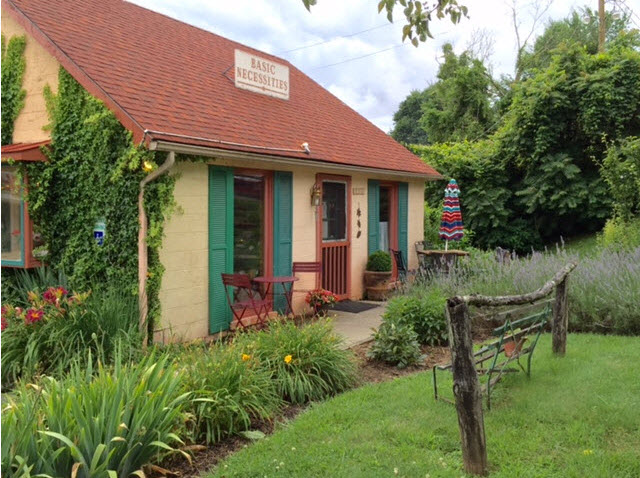
The cottage gardens at Basic Necessities
Lunch brought us off the mountain to a small cottage surrounded by a lush perennial garden where we met Kay Pfaltz, an avowed Francophile with a joie de vivre that’s indelibly contagious.
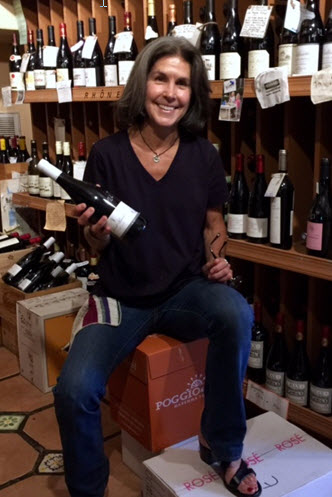
Let Kay Pfaltz choose your wine
Kay is the author of the charming memoir Lauren’s Story: An American Dog in Paris and co-owner of Basic Necessities with Sallie Justice and Rosie Gantt. Together they helm this restaurant and retail store. The enchanting spot reflects a distinctly French flair drawn from Pfaltz’s years as a writer living out her dream in Paris with her adored beagle, Lauren.
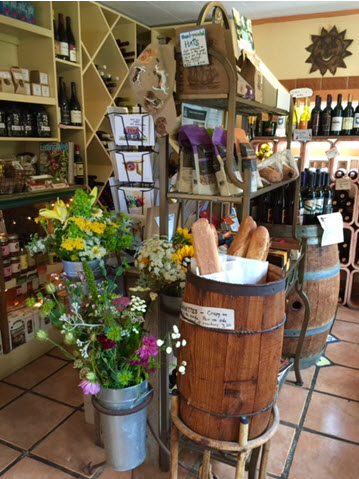
The shop at Basic Necessities
In the front section the shop is filled with a wide array of cheeses, freshly baked baguettes, patés and sausages – perfect for pairing with wines from Pfaltz’s expertly selected collection.
Pfaltz, who pens a local wine column, makes her selections based on taste, style and affordability and I homed in on a few sumptuous, well-priced burgundies and a number of carefully curated Virginia wines from the Commonwealth’s better winemakers. Her clientele certainly benefits from her discriminating, Gallic-honed palate to guide them.
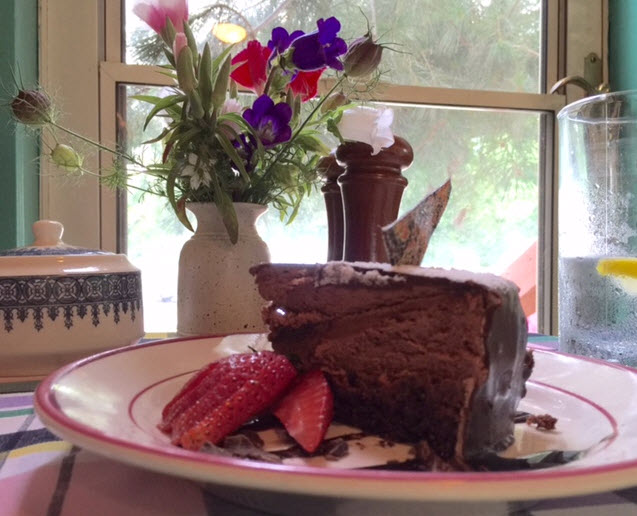
Chocolate cake at Basic Necessities
The dining area is in the back and overlooks more gardens. Provencal patterned tablecloths echo the French theme while floral print china and sprays of wildflowers in stone crocks adorn the tables. Lunches are served Tuesday through Sunday, with dinner service on Friday and Saturday nights only.
Thanks to Justice and Nelson County cook, Mae Collins Tyree, we were able to partake of a lovely French-inspired luncheon.
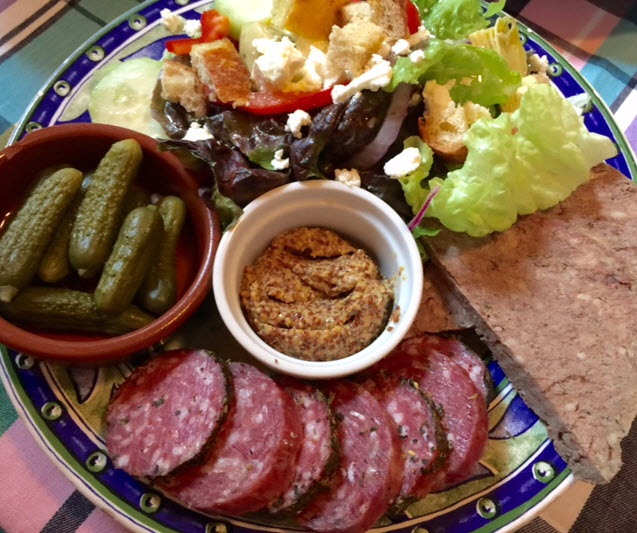
Charcuterie platter at Basic Necessities
I was particularly taken by the delicacy of a watermelon + tomato gazpacho, a classic Croque Madame and a lavish charcuterie platter with all the accoutrements. Pfaltz’s choice of a nice French rosé put us in mind of the French Riviera on a summer’s day. We capped off our French feast with a slice of richly dense and multi-layered chocolate cake.
Nelson County boasts ten wineries, three craft breweries, two cideries, one meadery and two distilleries. You will most assuredly not get to visit them all in one trip. We gave it our best shot and epically failed. However you choose to approach this tempting dilemma, it is ultimately more satisfying to focus on a few, all the better to savor the experience. In this way you’ll be able to spend quality time with folks eager to share their passion for the land and their commitment to their products.

Tony and Elizabeth Smith at Afton Mountain Vineyards
At Afton Mountain Vineyards winemakers Tony and Elizabeth Smith are proud owners of their upscale winery whose vines were planted in the 1970’s. Formerly known as Bacchanal Vineyards, the Charlottesville couple bought the vineyard in 2009, and doubled the acreage under vine. They expect their annual production of 2,200 bottles to increase to 5,000 in the next few years under the care and watchful eye of winemaker Damien Blanchon who hails from the South of France.
Currently the winery produces 15 varieties – something for everyone’s palate. Their 2013 Cabernet Sauvignon and 2012 Petit Verdot recently won gold at the 2016 Monticello Cup Wine Competition and they are exceedingly proud of being the area’s only producer of Pinot Noir.
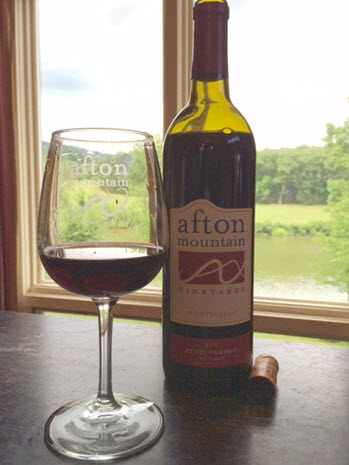
Enjoying a glass of Petit Verdot Reserve at Afton Mountain
From the elevated tasting room on a drizzly afternoon you might see a group of horseback riders make their way across the vineyard.
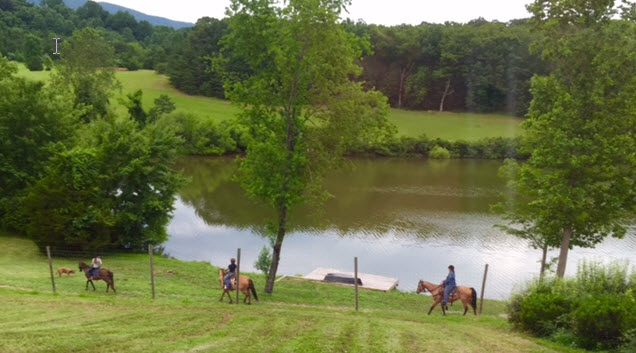
Riders tour the vineyards at Afton Mountain Vineyards
Rebel’s Run at Afton Mountain is a nearby stable providing guided tours of the vineyard and the scenic countryside. Riders stop in to relax with a glass of wine beside the lake before heading back to the stables. ‘Sip and Saddle’ packages can be booked through the stables or local B&B’s who pack box lunches for the riders.
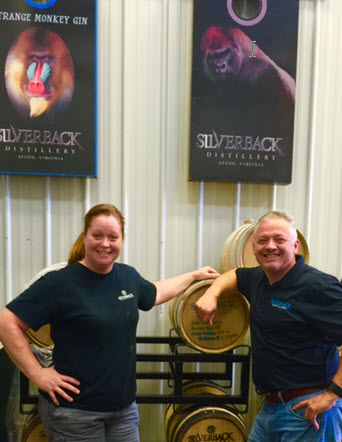
Christine and Denver Riggleman beside casks of their aged bourbon
A stop at the wildly successful upstart Silverback Distillery introduced us to Virginia-born owners Christine and Denver Riggleman. After years of living the transient military life and raising their three daughters, Denver offered his wife Christine the chance to choose their next path. To his utter surprise, she told him she wanted to start a distillery. Their daughters, who are very much hands on in the endeavor, voted on the nickname they had given their father, “Silverback”, after the massive gorilla – their term of endearment in reference to his large build. (He has since shed the excess pounds and it’s difficult to picture him as inspiration for the simian moniker.)
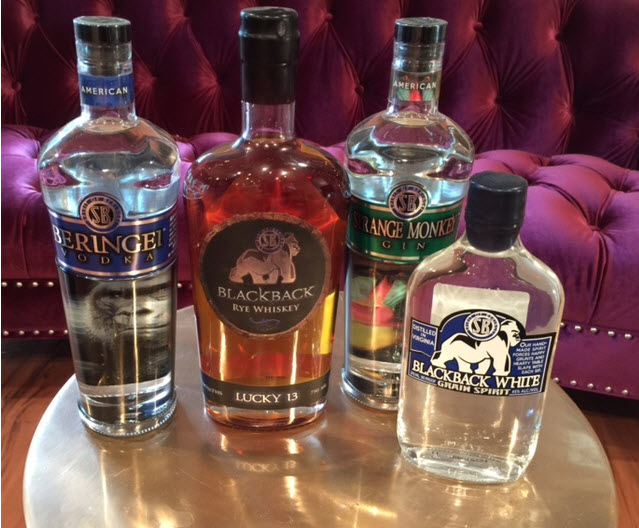
The tasting lounge at Silverback Distillery
Silverback Distillery opened for business less than two years ago and has already been the recipient of eight international awards. Combining a blend of Virginia grains with American craftsmanship, they currently offer Beringei Vodka, Strange Monkey Gin (winner of Double Gold at the San Francisco World Spirits Competition), Blackback White Grain Spirit and Blackback Rye Whiskey. An aged bourbon is coming soon. Stop in for mini cocktails – the London Mule with gin, ginger beer and lime juice was our favorite quaff. They have limited distribution and most sales are here at the Tasting Room, so be sure to pick up a bottle or two to take home.
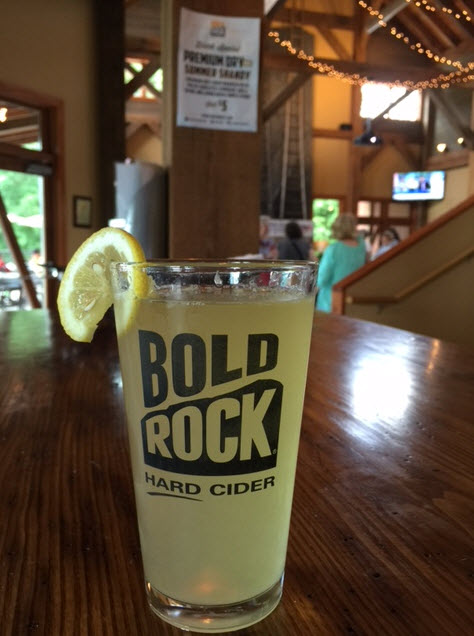
Bold Rock’s Tasting Room
Close by you’ll find two local craft cideries – Bold Rock Hard Cider uses 100% apples from the Blue Ridge Mountains of Virginia, while Blue Toad Hard Cider gets 100% of their apples from New York state. No concentrate bases whatsoever like the larger cideries. Farm to Tap.
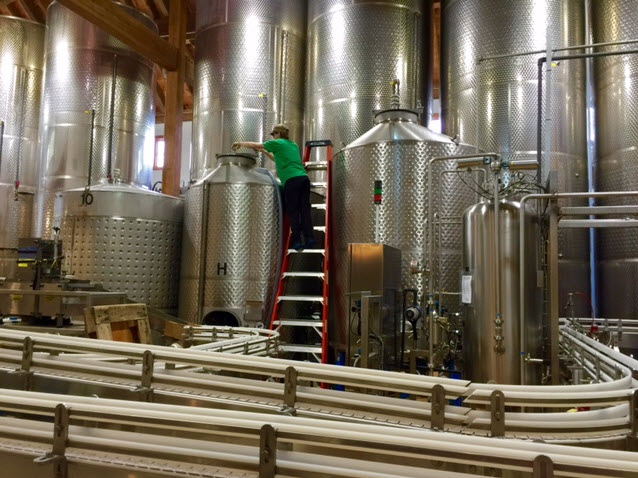
A worker checks the hoses on the tanks at Bold Rock Hard Cider
Bold Rock is a massive operation with three locations in Virginia and one in North Carolina, while Blue Toad is a tiny speck on the map. Try them both and judge for yourself.
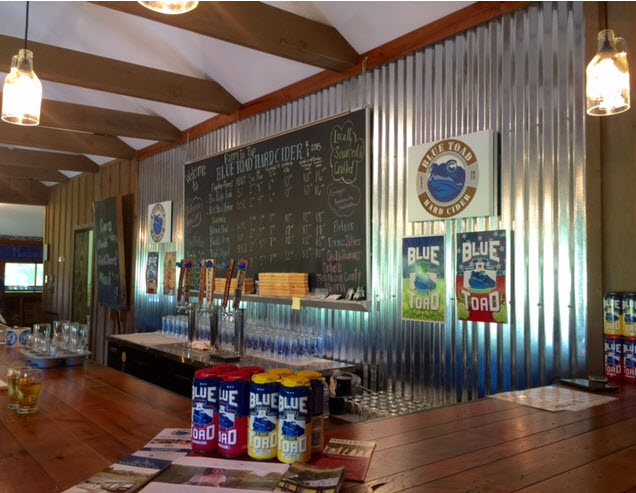
The Tasting Room at Blue Toad Hard Cider
If you’re looking for an active bar scene, Devils Backbone Brewing Company is nearby. This large craft brewery, recently purchased by Anheuser-Busch, is set on 100-acres of farmland with plenty of outdoor seating in its naturalistic gardens. Families congregate at the covered outdoor bar as children explore the paths.
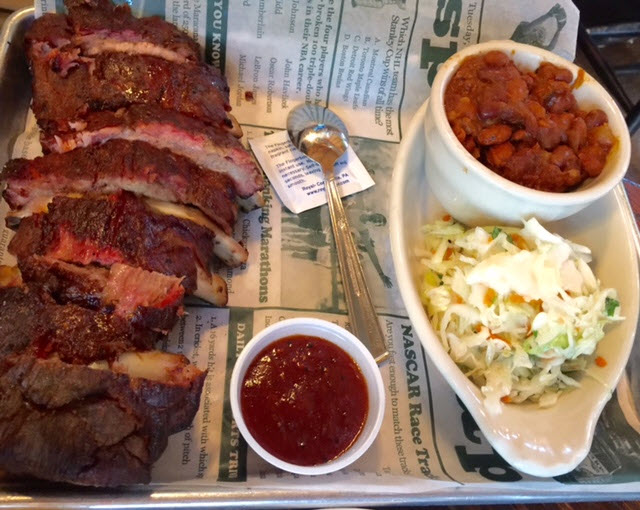
Barbecue at Devils Backbone
The restaurant features sixteen beers on tap to pair with simple pub food.
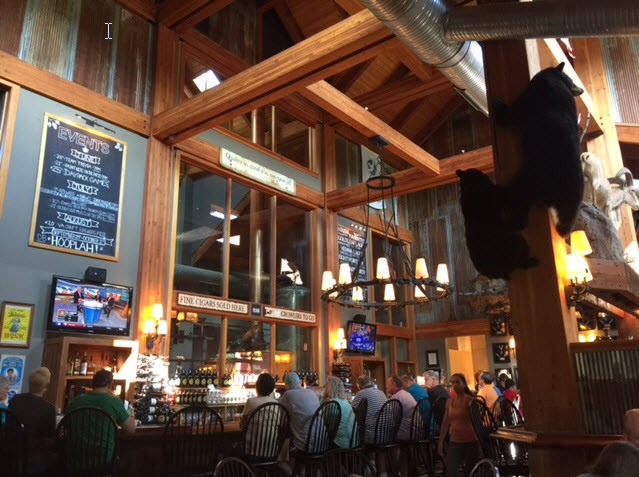
The restaurant at Devils Backbone Brewing Company
If you’re lucky enough to be in Nelson County on a Saturday, head for the farmer’s market. Along with pretty flowers, fresh fruits, cheeses and veggies, you’ll find some unusual vendors like local bladesmith, T. Hipps, whose line of heirloom quality handmade cutlery called Karma Blades, will set you apart from the run-of-the-mill chef or hunter. Or Lynne Ross of La Sunflower who makes her beauty products with comfrey and other natural home grown herbs.

Purple cauliflower from the season’s bounty
Stop by Barefoot Bucha’s stand to try their organic kombucha made locally with organic ingredients and served on draft and pick up a homemade lemon meringue pie from The Hungry Fox.
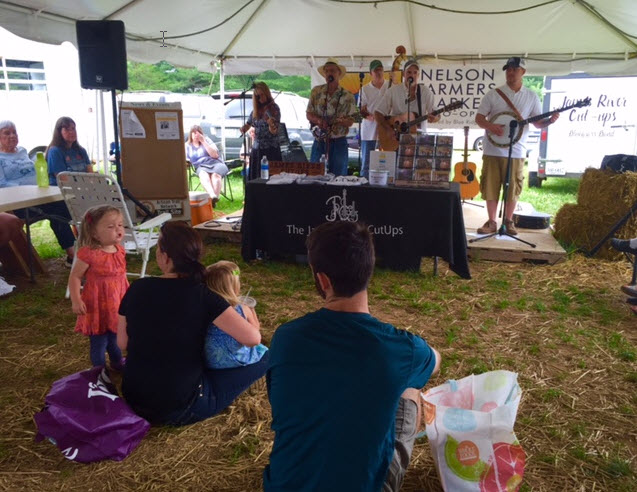
The James River Cut-ups entertain the crowd at the Nelson County Farmers Market
Hopefully you brought a cooler to take home John and Jade Sonne’s organic pork, eggs and berries from Spruce Creek Farms and some kimchi and fermented drinks from Farmstead Ferments.
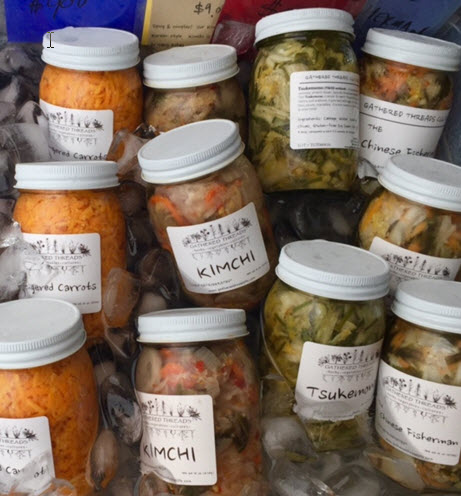
Fermented vegetables from Gathered Threads
Where else can you find okra hot dogs and cider brats? Why from The Rock Barn, of course. Other unique finds are fermented vegetables from Gathered Threads, who offer wide range of products from tsukemono, gingered carrots and apple & juniper sauerkraut.
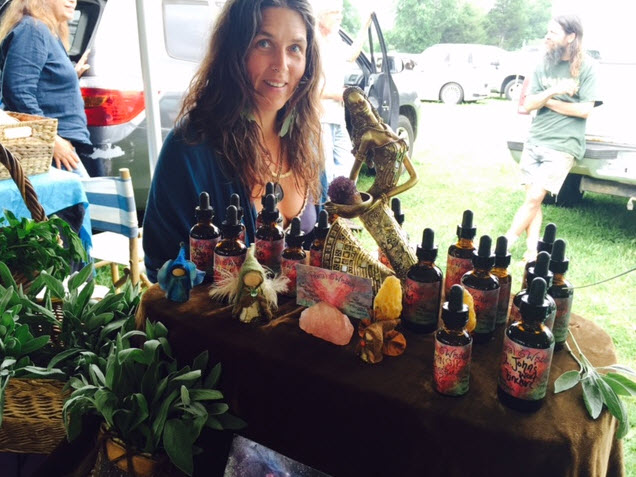
Essences from Primal Wisdom
My personal favorite from Virginia Vinegar Works is ‘Blackberry Cabaret’. Not too sweet, not too tart – it’s the perfect addition to any kind of salad.

Sandy Beebe shows her artwork
And, if you want to know why painter and printmaker Sandy Beebe, whose works are reminiscent of Grandma Moses, moved to Nelson County, she’s at the market every Saturday and is delighted to chat about its charms.
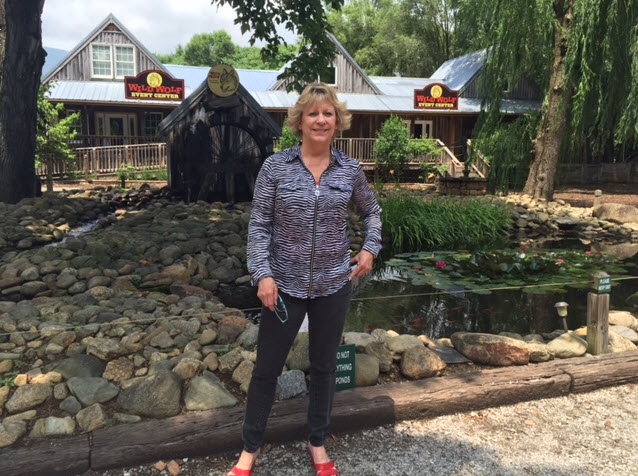
Mary Wolf owner of Wild Wolf Brewing Company
All this food and no stove to cook it, was making us hungry. So turning back onto the Brew Ridge Trail we headed for lunch at Wild Wolf Brewing Company to meet owner Mary Wolf whose son Danny Wolf is the Master Brewer.
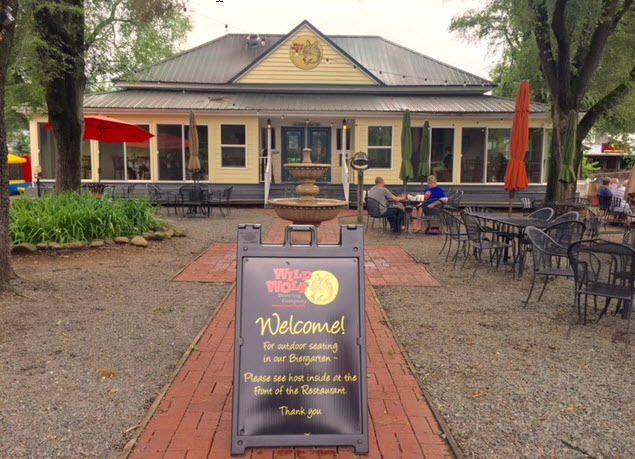
Wild Wolf’s restaurant is housed in a restored schoolhouse
This unique, eco-friendly, family-owned brewery, offers a wide array of beers and a restaurant housed in a former 1910 high school with wrap-around porches. Stroll around the 10-acre former garden center to enjoy ponds, a water wheel, a biergarten and rustic outbuildings.

The Gazebo gardens at Wild Wolf
The restaurant has an exceptional Head Chef in Chris Jack, and a talented Pastry Chef and Baker in Higgins Stewart, both of whom create truly memorable food. According to Mary two years ago she and Danny decided to go farm-to-fork. Now they send spent grain from their hops to a local farmer to feed his cattle in trade for beef.
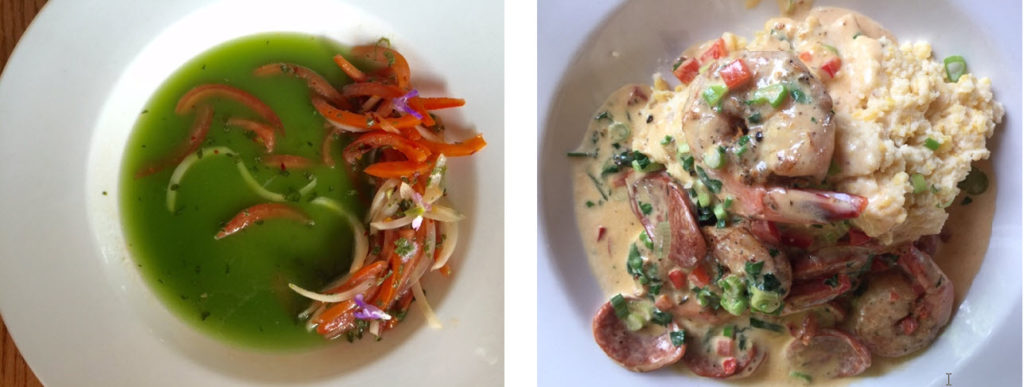
Herbed gazpacho ~ Shrimp and grits
Eggs come from the chickens that live beneath their hops vines, and there’s a vegetable garden for much of the produce and summer herbs tucked into Jack’s dishes.

Chickens feed on insects beneath the hops vines at Wild Wolf
In the kitchen heritage breed Autumn Olive pigs are butchered for sausages and the ground pork is added to burgers. Grits are prepared using stone ground corn from the nearby Woodson’s Mill in Nelson County. The craveable, crisp-crusted cornbread brought steaming hot to the table in wire baskets, is made with Ula Tortilla’s organic, locally grown, non-GMO corn flour. This rustic restaurant retreat is a must stop for excellent, chef-driven local cuisine and hoppy IPAs made with Cascade hops used in their “Primal Instinct” IPA. We loved knowing Wild Wolf was selected as the Virginia Green Brewery of the Year.
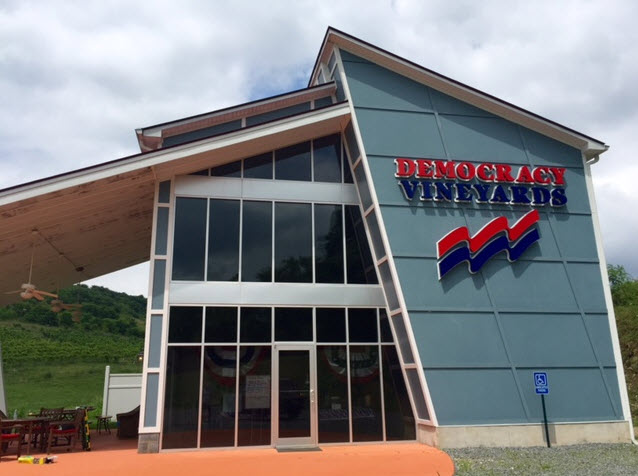
The Tasting Room at Democracy Vineyards
Was it the wine or the beer? But somehow we missed the turnoff to Del Fosse Winery leading us to a scrappy little vineyard that hadn’t been on our radar. Democracy Vineyards may not be on many people’s list, but we loved its quirky theme and amazing collection of political memorabilia that lines the walls of the ultra-modern tasting room. Started by Susan Prokop and Jim Turpin on an old apple farm, Democracy now features eleven wines with such startling names as ‘Suffrage’, ‘Freedom’, ‘Magna Carta’ and ‘Velvet Revolution’. Be sure to taste their ‘Parliament’ 100% Petit Verdot dessert wine, and ‘Freedom’ a ‘Pinotage’ varietal.
A short drive away is the Virginia Distillery Company, where the elegantly furnished Visitor’s Center signals this luxury brand. This summer the company launched ‘The Virginia Whisky Experience’, a one-of-a-kind guided interactive tour and museum experience for its visitors. It includes a tour of the state-of-the-art distillery and the Cask House ending in a tasting of their Virginia Highland Malt and a sampling of their craft cocktails either in the Visitors’ Center or on a 2,000-foot patio replete with water and fire features.

Inside the distillery
Fed by seven converging springs, the distillery was the dream of George G. Moore, an American visionary who was determined to see Virginia whisky come back to an area once better known for its Prohibition Era stills. Moore died three years ago and the project was taken up by his son, Gareth Moore and wife, Maggie, who have shown the same pioneering determination. While VDC’s whisky was aging in used bourbon casks for a minimum of three years, they began distilling and aging their Virginia Scotch Whisky in the Scottish Highlands and shipping it back to Lovingston, finishing here in port-style wine casks where it will age for six to twelve months. Not all the malted barley will come from Virginia, as there are not enough local farmers able to fulfill their needs, so most will be sourced from Scotland’s famed Boby malt mill.

Guests settle in for a tasting of Virginia Highland Malt
Until their on-site product has aged completely, the tasting room offers the Scottish-distilled Virginia Highland Malt in a number of specialty cocktails. We particularly enjoyed the ‘South of Manhattan’ which we paired with their specialty Gearhart’s Chocolates Whisky Truffle made with their Highland Malt and sold in the gift shop.
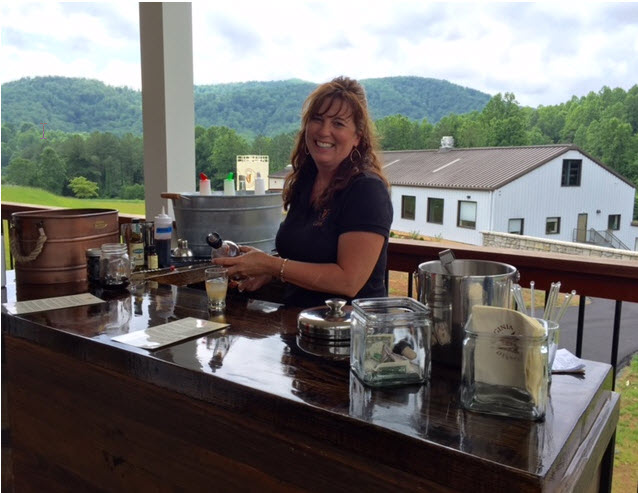
Carol mixes the ‘South of Manhattan’
‘South of Manhattan’ Cocktail from Virginia Distillery
- 4 ounces Virginia Sparkling Cider
- 1/2 ounce Luxardo cherry juice
- 2 dashes cardamom bitters
- 2 ounces Virginia Highland Malt Whisky
- Orange peel
- Luxardo cherry, for garnish
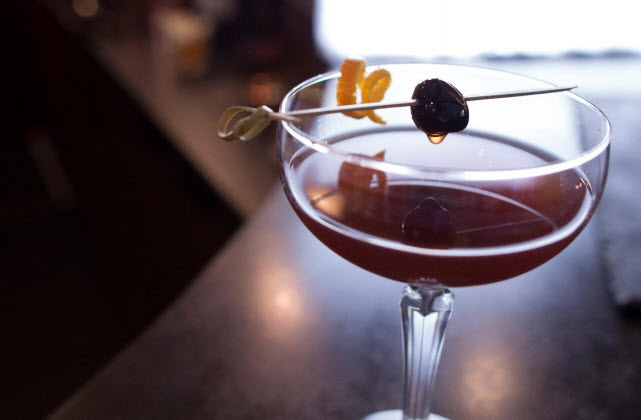
South of Manhattan
In a shaker, mix together cider, cherry juice and bitters. Add two ice cubes and the Virginia Highland Malt Whisky. Stir and strain into a coupe glass. Rub the rim of the coupe glass with the orange peel and garnish with the Luxardo cherry and the orange peel.
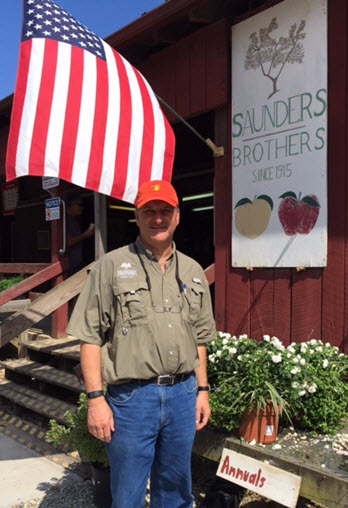
Fourth generation owner Jim Saunders
Jim Saunders is the fourth-generation owner of Saunders Brothers founded in 1915. The affable farmer took time to drive us in his bright red truck through hundreds of acres of peach, apple and Asian pear orchards plus 36 varieties of boxwoods. (You’ve probably seen their boxwoods in the White House gardens, planted during the Kennedy administration.)
Bouncing along the rutted farm roads, Jim regaled us with tales of the 1200-acre Nelson County farm. Jim’s father, Paul Saunders, is the family genealogist and successful author, penning two wonderful books, “Heartbeats of Nelson”, a fascinating 634-page photo-filled anthology on the history of the county and its people, beginning in pre-Civil War times to the present day. His second book, “Down on the Farm”, tells the history of the Saunders’ family life and the business of running the farm. You can get pleasantly lost in these emotionally-connected stories of life and times by the Piney River.
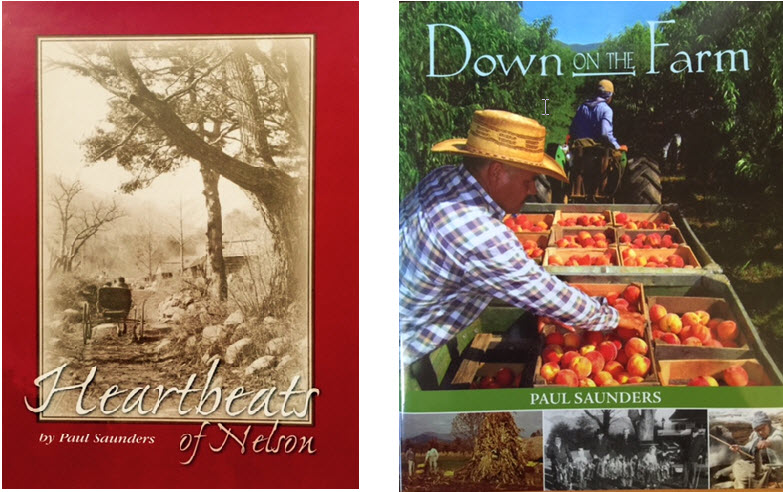
Author Paul Saunders – Heartbeat of Nelson & Down on the Farm
We finished the tour in the farm store with Homestead Creamery’s delicious homemade peach ice cream from their Farm Market and left toting a basket of early yellow Sentry peaches destined for our cobblers. Look for Saunders peaches, apples and pears at Whole Foods. Their Albemarle Pippin was Thomas Jefferson’s favorite apple and is great for baking as well as cider.
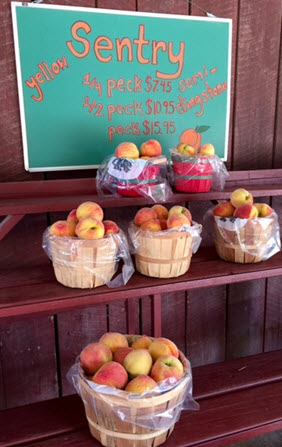
Early season Sentry peaches
The Rock-n-Creek Cabin is the most unique accommodation I have ever come across. A rustic two-level A-frame cabin with wraparound porches, it is set in the woods and encircled by a series of ponds. And though I was not particularly keen on the unidentifiable insects flitting around the bathroom floor, it’s more luxurious than camping out.
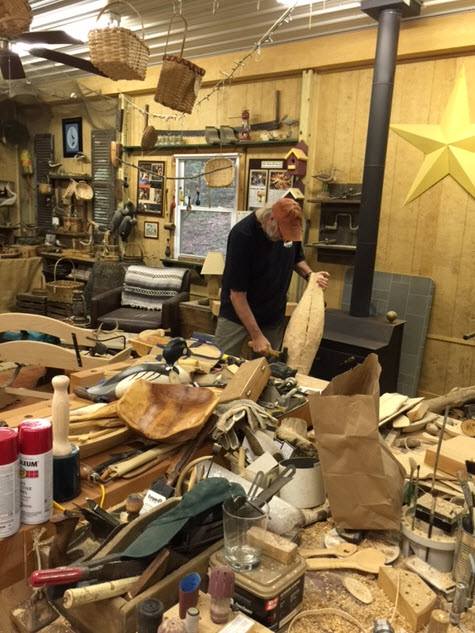
Amid his oak baskets Christy gets to work on a new decoy.
Host and owner Richard Christy is a renaissance man. He is an accomplished chef, caterer, self-taught decoy and shorebird carver, and basket weaver. His Buck Island Bay Decoys and Mountain Man Basketry studio is adjacent to the cabin. I tell you this because you will be interacting with him as he prepares your dinner. He is a font of information about the area’s wonders and a fascinating conversationalist. As a former chef to Gerald Ford, he has helmed many restaurant kitchens around the country and continues to consult on new food products for major producers.
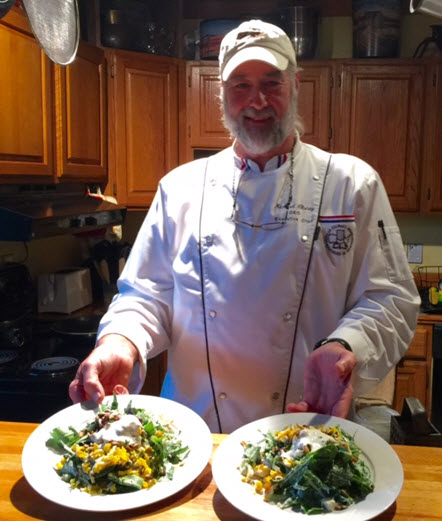
Richard Christy Chef/Owner of Rock-n-Creek Cabin with the first course
Back to the experience. When booking your reservation, Christy will ask what style of cuisine you would like him to prepare. In my case I left it to him, and after he had checked out this website, he decided he would do something un-restaurant-like and totally out of the ordinary, choosing to prepare a “wildcrafted” dinner sourced entirely from wild edibles – with the exception of the vanilla, flour and sugar used in the dessert.
Our dinner was entitled ‘WILD THING – I Think I Love You’ and Christy presented us with a beautifully printed menu of our three-course dinner.
As we sipped our wine from barstools looking through to the open kitchen, the pony-tailed chef tossed freshly foraged salad greens – creek lettuce, lamb’s quarters, dandelion, chicory and cattail hearts – topping them with grated pickled duck egg, toasted pumpkin seeds and buttermilk dressing. Our palate refresher was “Apple Pie Moonshine”, his signature concoction of homemade moonshine, cinnamon and apple cider. Strong medicine meant for those who spend the day foraging and hunting in the woods as opposed to tooling around country roads in an air-conditioned SUV.

Blue catfish entree
We took our seats in candlelight while Christy prepared our next course – blue catfish filets in brown butter on creamed ramps and nettles, finished with preserved fig. A side of savory sweet potato and caramelized onion puree added sweetness and extra complexity. It was divine!
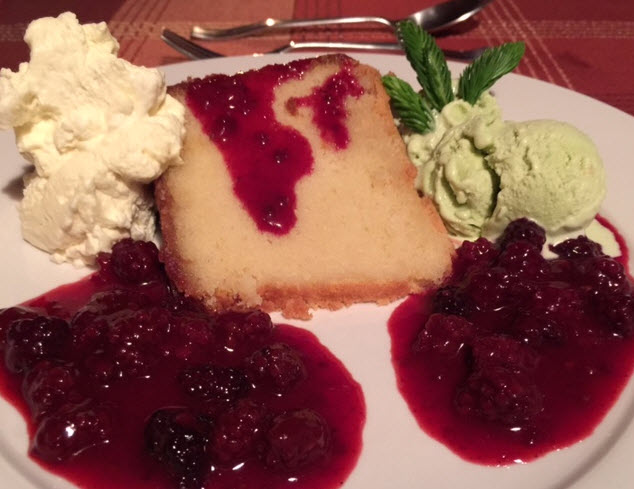
Pound cake with wild blackberries, honeysuckle crema and spruce tip ice cream
Dessert was a harmonious medley of foraged ingredients. Dense pound cake served with stewed wild blackberries and enhanced with honeysuckle crema and hand-churned spruce tip ice cream. I can assert without equivocation that I have never enjoyed a meal more uniquely delectable.
The cabin with its full-sized kitchen has all the amenities you’ll need whether your bringing the whole family or looking for a romantic getaway for two.
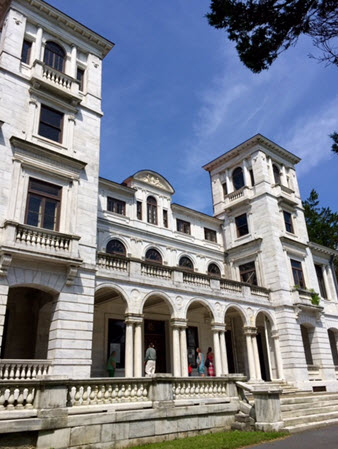
A small group of visitors await a tour of Swannanoa Palace
High atop the Blue Ridge Mountains sits Swannanoa Palace – one of those intriguing places, you never knew existed.
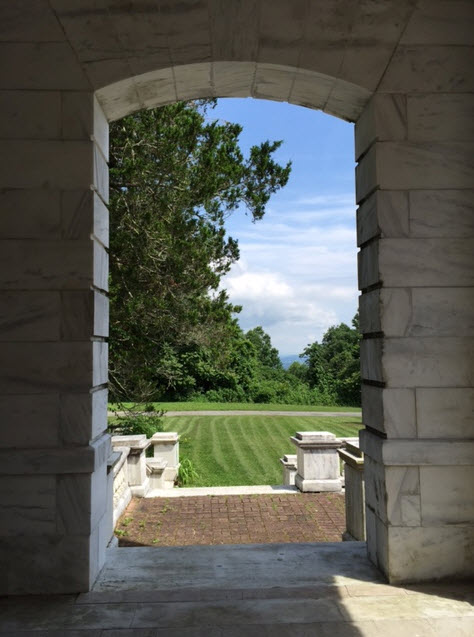
A view from the mountaintop at Swannanoa
Built in 1912 to replicate the style of the Villa Medici in Italy’s famed Borghese Gardens, millionaire philanthropist and railroad magnate James H. Dooley and his wife Sallie May used the 22,000-square foot Italian Renaissance Revival villa as their summer mountaintop retreat. (You may be more familiar with the Dooleys’ better known Maymont home and gardens set beside the James River in Richmond.) It is divinely lavish with exquisite frescoes, carvings and massive fireplaces of Sienna and Carrara marble. Hidden doors and a secret elevator are revealed to the curious visitor, and the incongruous ‘Persian Smoking Room’ features teakwood carvings, mosaics and a mosque fresco above the fireplace. An exquisite Moorish lantern, bejeweled with sapphires, rubies, amber and opals, hangs above the exotic decor.

Architectural details abound in the decaying palace – A bejeweled Moorish lantern lights up the ‘Persian Smoking Room’
The 52-room Afton mansion appears to be haunted and one group claims evidence of the ghost of Sallie May. A few years ago a team of ghost hunters from the Twisted Paranormal Society set up night beams and recording equipment in the mansion claiming to have recorded spirits within. One year later they returned under the auspices of another paranormal show called The R. I. P. Files attempting to identify the ghosts who reside there.

The expansive pergola depicted in the Tiffany window has fallen into disrepair
The white marble palace is mostly abandoned, but guided tours of the ground floor and gardens are given seasonally from May through November on Saturdays and Sundays.

A Tiffany window at the top of the grand stairway portrays Sallie May Dooley in her gardens at Swannanoa
On our tour Victoria Airisun Wonderli, author of Swannanoa Palace – A Pictorial History of the Past and People, was busy signing her fascinating book on the history of the mansion. There is currently no website for the property. For information on visiting hours call 540 942.5201.
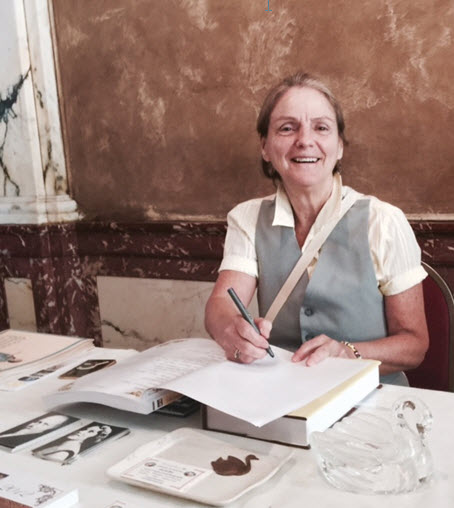
Author Victoria Airisun Wonderli signs her book on Swannanoa
It was high time to shed any notions of ghosts and spirits and things that go bump in the night. And what better way to exorcise the demons than a glass of wine and a spot of lunch?

Cardinal Point’s grounds provide stunning views of the mountains
When we arrived for lunch on Sunday two musicians were playing mellow tunes on the deck at Cardinal Point Winery. Overlooking gardens abloom with roses and daylilies, we settled into a spacious sofa feeling carefree and peaceful.
As the duo took requests, we gobbled up a delicious box lunch of salad and sandwich while alternating between Vinho Verde-styled, ‘Green’ and a lively estate-grown Cab Franc rosé. Ginger and Maya chocolate bars from Gearhart, the Richmond-based artisanal chocolatier, were the sweet finish.
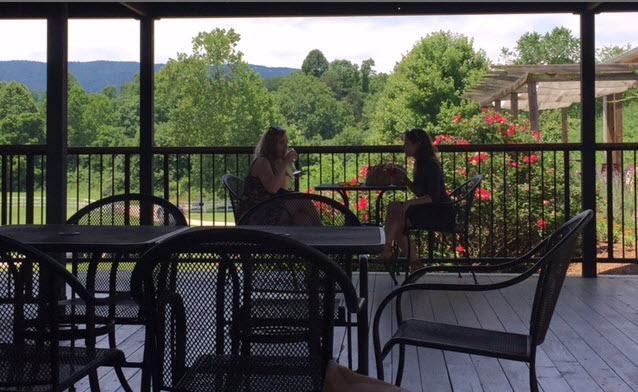
Lunch on the covered deck at Cardinal Point Winery
During lunch, Sarah Gorman, sister of owner Tim Gorman, spoke with us about the evolution of her brother’s vineyard which currently has 15 acres under vine.
She told us how Tim, one of a smattering of Virginia owners who is also a grower, came to be a winemaker. Tim is known for his fresh and innovative takes on classic vinifera, and naturally is very passionate about the growing side of things. Gorman got into winemaking as a result of being frustrated by how the grapes he was growing for other vineyards were not being honored. A creative winemaker, he prefers to ‘read’ the grapes when they are ready. This tells him what kind of wine to make as opposed to having to force a grape to become something other than what it should be.
In a small winery such as this, he can come up with innovations, and he does. His ‘Clay Hill’ Cabernet Franc, made with grapes from a neighboring vineyard, was a 2016 Virginia Governor’s Cup Gold Medal winner. A classic Loire Valley style, it has also done well in international competition. Be sure to sample some of these unique wines unknown to other Virginia wineries – like the 2014 ‘Quattro’ made from Riesling, Gewurtztraminer, Viognier and Traminette grapes for an off-dry wine with notes of candied apple and pear.
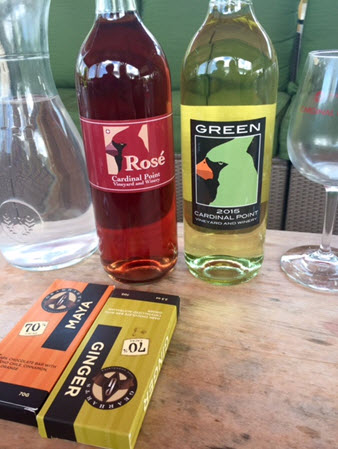
Wine and chocolates at Cardinal Point Winery
Interpreting how each fruit has evolved in a season allows Tim to inform his winemaking decisions. For his 2015 ‘Frai Chardonnay’, a wine with peach, pear and tropical notes, he stopped the ferment short of dry, leaving it with only 2% of residual sugar. Sarah mentioned that the 2015 unoaked ‘Hopped Chardonnay’ is flying out of the tasting room with buyers surprised at how differently a chardonnay grape can be expressed.
The winery also features a five-bedroom 19th century farmhouse for overnight stays. Check the website for upcoming events.
After doing a bit of shopping at Tuckahoe Antique Mall, we pressed on to Veritas Winery where we would spend our final night. No, not in a vat of grapes, but at the bespoke Farmhouse at Veritas.
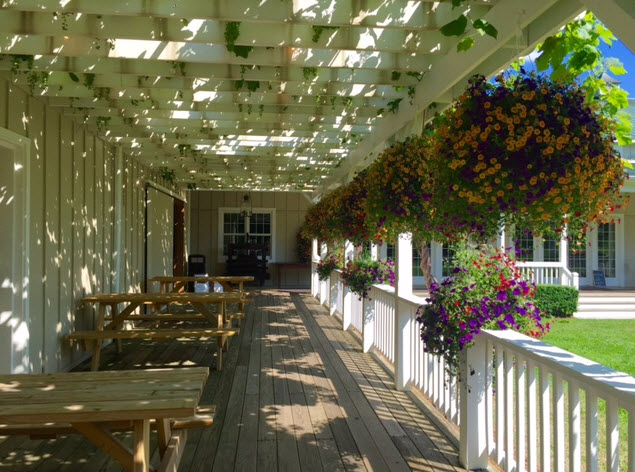
The flower filled pergola greets visitors to Veritas Winery
What we came upon was a breathtaking winery with vast expanses of green lawns, acres and acres of vines and a production facility that sustains a wine-drinking clientele of over 3,000 club members and boasts a grand ballroom for weddings and large events.

The busy tasting room at Veritas Winery
Founded by Andrew and Patricia Hodson, a British couple who moved to the county to lead a quieter life, they thought they’d put a few acres under vine. In a short time, their flight of fancy became one of the most successful, and stunning, wineries in Virginia with many of their family members filling the roles of winemaker and managers. We took a lengthy tour of the production facilities which are vast. And though I took reams of notes, most are cryptically abbreviated. Here’s what I can be sure of. All their grapes are grown in the Monticello AVA, which consists of four counties including Nelson, and they bottled and sold their first wines, Cabernet Franc and Petit Verdot, in 2002. Their philosophy is to exclusively use estate or local grapes and they are most excited about a merlot they are testing using grape pomace (the skins, pulp and seeds from grapes).
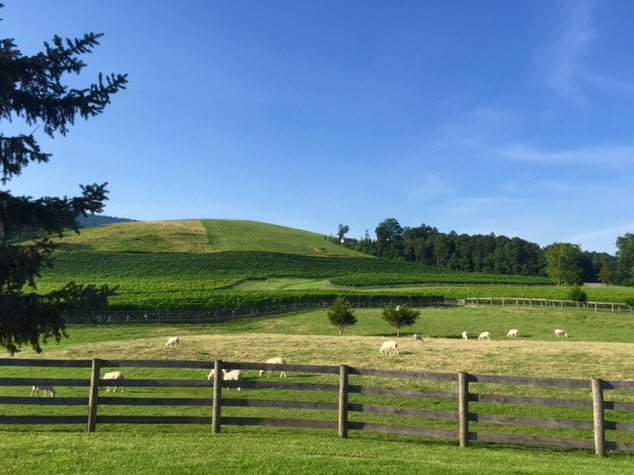
Sheep graze alongside the vines at Veritas
As for the technical stuff, they employ a reverse osmosis machine and a state-of-the-art gyro cube for riddling and they are very proud of their gravity-fed vineyard. I felt myself going into shutdown mode, either from too much technical stuff, or the fact that we had come inside to refrigerated cellars from 98-degree heat.
The tasting went swiftly as I passed over some too young reds to get to the best of the lot. The 2014 ‘Vinter’s Reserve’ Red is their most promising wine right now, as the 2013 cuvee won the Gold Medal at the Governor’s Cup and I found the 2013 Petit Verdot to be coming along nicely. I had a particular affinity for the 2015 Viognier which is touted as cellaring well, and a more delicate than expected version of ice wine called ‘Kenmar’.

The Farmhouse at Veritas
We checked into The Farmhouse at Veritas, more of a bespoke estate home, elegantly appointed with walls of books, an old-fashioned billiard table in the Gathering Room and fine antiques. High-end decorator touches grace the eight suites that are outfitted with high-quality linens and premium amenities. Not your typical roadside B&B, the 1839 home was where the Hodson family lived when they first took ownership of the former horse and cattle farm. Guests can also opt for ‘The Barn Cottage’, a charming two-bedroom, two-bath cottage with a fireplace in the living room and a full-size kitchen available for guests.

Outdoor dining at Blue Mountain Brewery
As much as I preferred to luxuriate in such splendor and sneak off with a book to the second-story front porch, we took off down the road for dinner at the Blue Mountain Brewery where we arrived in time to watch the sun set. The award-winning brewery is proud of its 20 varieties of craft beers made with their own hops, Simcoe, Cascade and Centennial, and using deep well water as well as brewing exclusively in Nelson County since 2007.
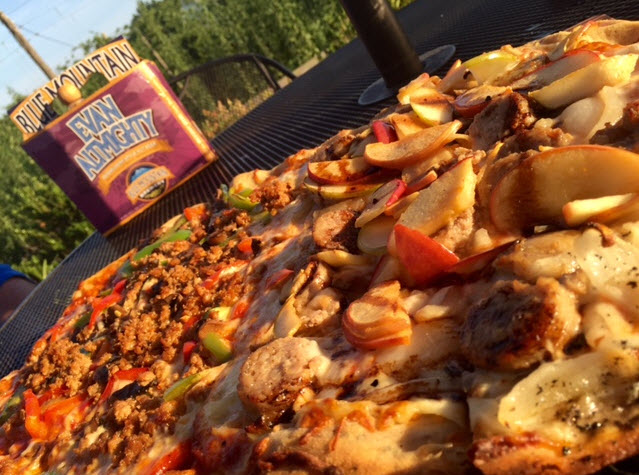
Combo pizza at Blue Mountain Brewery
Char-grilled pizzas and burgers including plenty of vegan options are made from scratch and designed to pair well with a myriad of beers. (Local wines and even kombucha are available too.) We sat on the outdoor terrace watching kids run around the lawn while a lively group played cornhole. Check the website for upcoming Oktoberfest events.
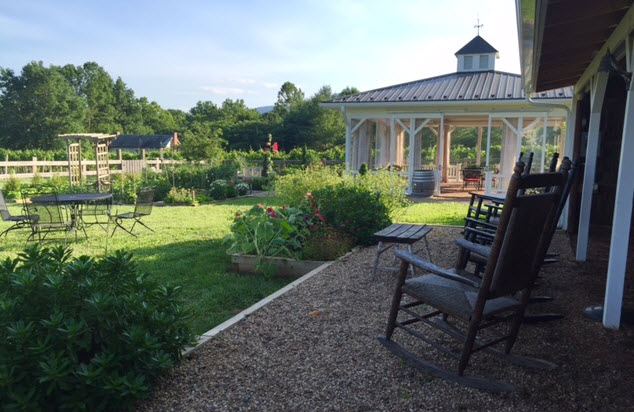
The potager garden and dining gazebo at The Farmhouse at Veritas
Morning at The Farmhouse brought a champagne breakfast of fresh fruits, croissants and omelets prepared to your liking by the estate’s chef. We eschewed the screened-in porch to enjoy the pleasures of a large brick-floor gazebo. Surrounded by the raised beds of the kitchen garden and row upon row of Chardonnay vines we whiled away the hour sipping the aforementioned Mousseux while butterflies and honeybees flit about the roses and coneflowers. A very civilized way to begin the day before returning homeward. Check the website for upcoming yoga and hiking retreats.
